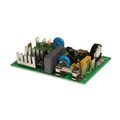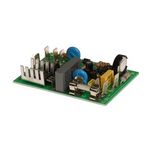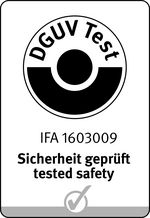Suitable to brake three-phase- and AC-motors
The brake control meets the requirements of EN60204 Art. 9.2.5.4.2 „emergency stop function“ in category 1.
Features
- Brakesystem according to DIN EN 19085-1, Pl = b according to DIN EN ISO 13849-1
- Good value for money
- Maintenance free
- Easy to mount in all our series
- Braking current adjustable
- No brake release required (e.g. necessary for blade changes on mechanical brakes)
Models and Prices Electronic motor brake up to 10 A
| Image | Description | Art.-No. | Price incl. VAT |
|---|---|---|---|
 | With adjustable braking time | 8702.0005 | € 56,42 Order In Stock: 1020 |
Functional description
Electronic brakes are used to brake asynchronous machines in squirrel-cage design and Single-phase AC capacitor motors within 10 seconds. Therefore an adjustable DC flows through one or more windings of the motor after operating supply is switched off. This current is generated by a thyristor phase control for a fixed time. High currents are induced in the counter-field rotating squirrel cage, resulting in an accordingly high brake torque.
Protection of the brake
We equip all switches with a patended switch adapter (circuit breaker) to protect the electronic brake from short-circuits and voltage peaks particularly in the event of restarts during the braking operation.
Motor heating during brake operation
The motor heating during braking with DC correlates with the heating during motor start. If a motor is frequently started and stopped a temperatur should be mointored by a thermistor.
Adjusting brake current
The braking current depends on the motor and flywheel mass. It can be adjusted with a potentiometer. Our experience from several projects in the past shows that it is reasonable to test the motors and its flywheel mass in our development centre when production quantities warrants this additional effort to ensure the optimum adjustment of the brake. On request external adjustment of the brake can be realised for all our available switches.
We have profound experiences in braking moduls for many years. That's why we are the right partner for electronic brakes.
Technical data
| Nominal voltage | 230 V 50-60 Hz or 400V 50-60 Hz, depends on model |
| Voltage | 230 V~ 50/60 Hz = Article-No.: 8702.0005 |
Max. braking current | 10 A |
| Performance level | PL = b according to DIN EN ISO 13849-1 |
| PFH | 1.14x10-6h-1 |
| Certification number | IFA1603009 |
| Power semiconductor | Thyristor = 12 A/800 V Diode = 6 A/1000 V |
| Backup fuse | 16 AgL |
| Connections | With flat receptacles 6.3x0.8 mm |
| Active brake time | Optional approx. 6 s and approx. 12 s or adjustable (Art.-No.: 8702.0005) |
| Adjustment of braking current | Continous adjustable, depends on motor and wiring |
Braking frequency | 10 % ED with10 s braking time (36/h) |
Activation time | 300 ms |
| Function | Phase control |
| Method of operation | DC braking |
| Use | Sinusoidal mains voltage necessary, no generator operation possible |
| Optical display | With brake indicator on request (indicator for blown fuse) |
| Ambient-/Storage temperature | -10° C ... +45° C / -25° C ... +75° C |
| Energy consumption | 230 V / 400 V ca. 0,3 W/0,6 W |
| Dimensions | 75 x 54 x 25 mm (LxWxH) |
| Weight | ca. 58 gr |








